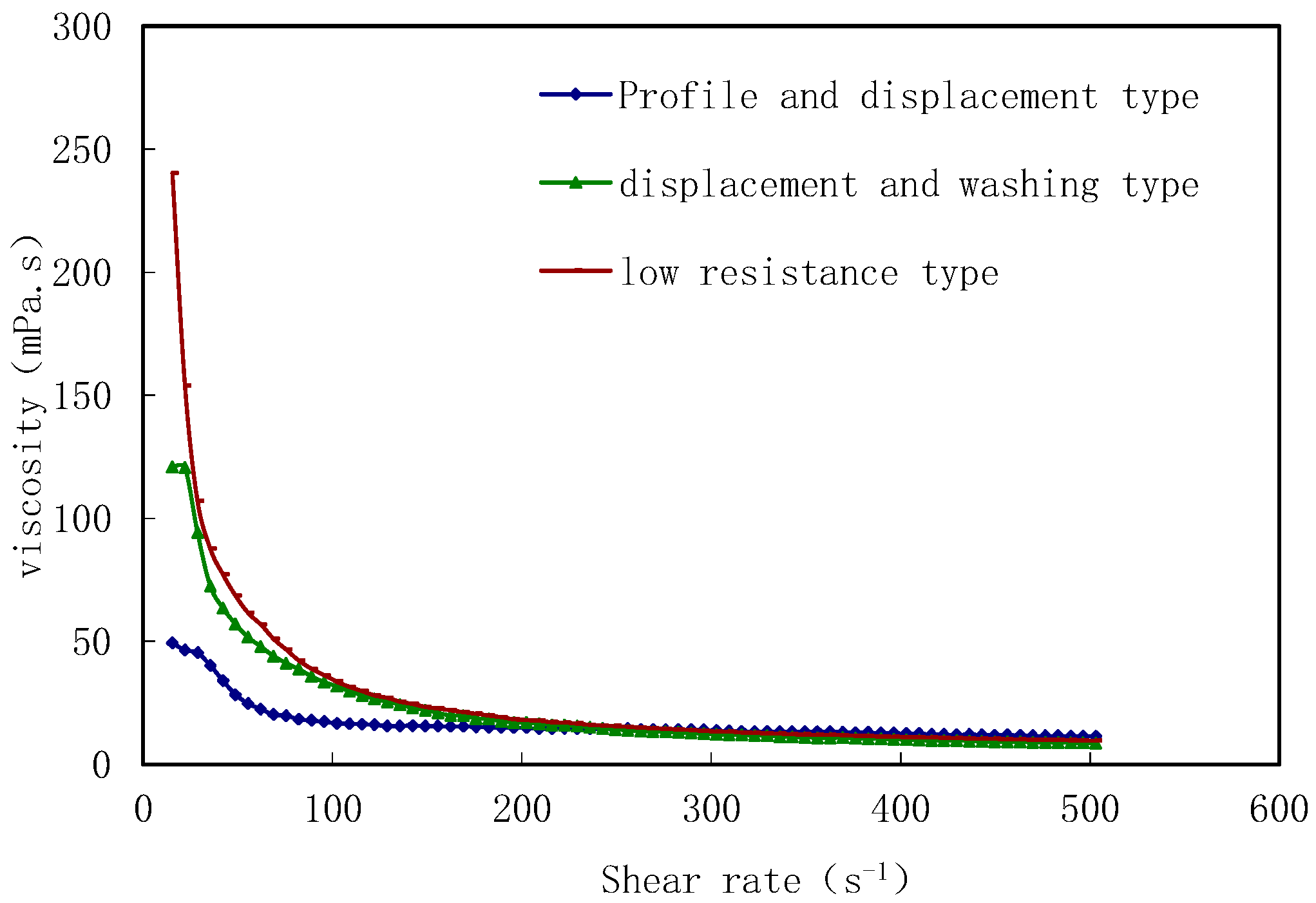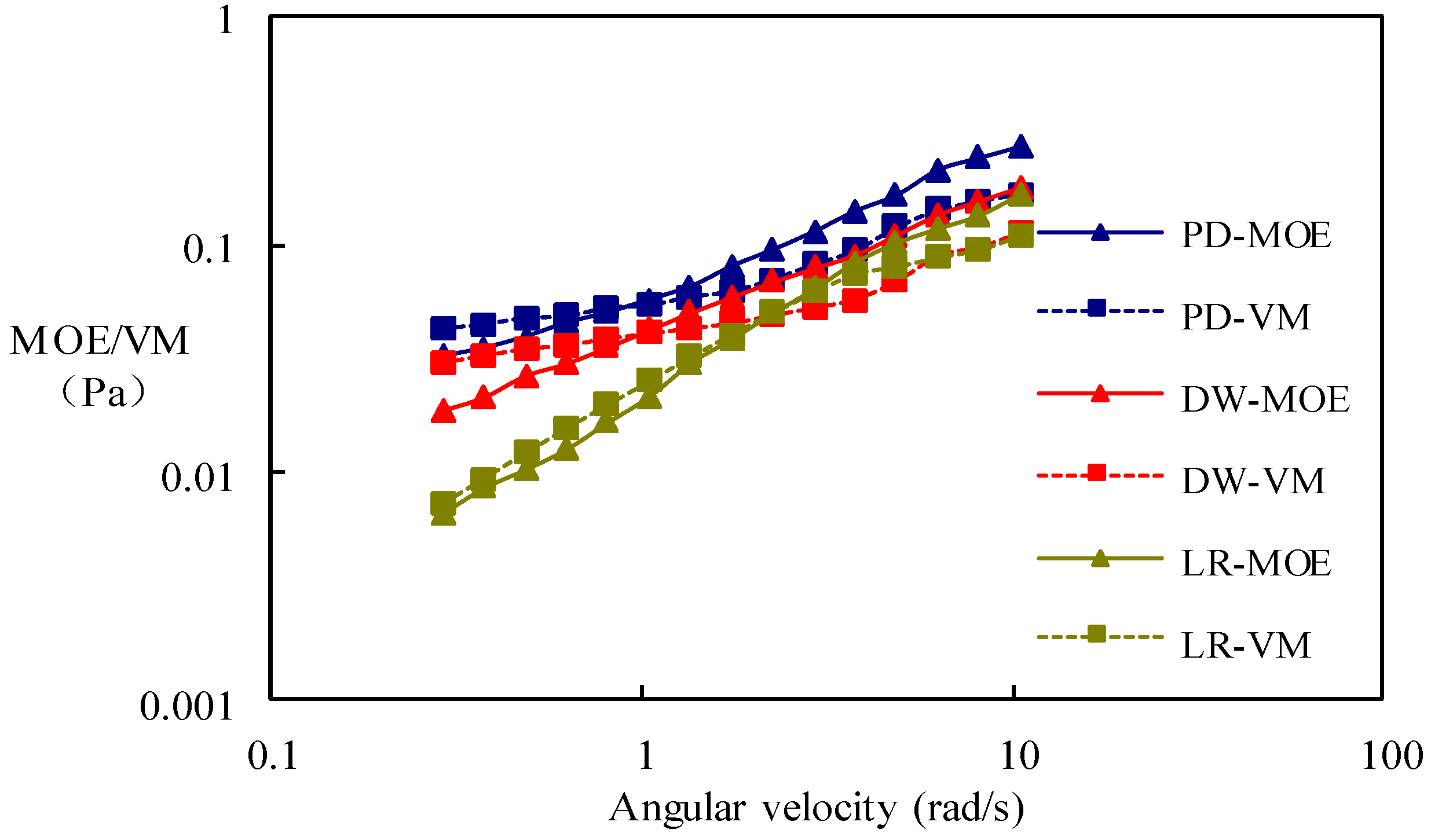A Laboratory Experimental Study on Enhancing the Oil Recovery Mechanisms of Polymeric Surfactants
Abstract
1. Introduction
2. Results and Discussion
2.1. Physical and Chemical Properties of Poly-Surfactant
2.1.1. High Viscosity Improvement Ability
2.1.2. Shear Dilution
2.1.3. Viscosity Stability
2.1.4. Salt Resistance
2.1.5. High Viscoelasticity
2.2. The Influencing Factors of Oil Displacement Effect
2.2.1. Viscosity
2.2.2. Dehydrating Rate of Emulsion
2.2.3. Permeability
2.3. Study on the Mechanism of Micro-Oil Displacement by Polymeric Surfactant Flooding
2.3.1. Enhanced Oil Recovery
2.3.2. Mechanism of Micro-Oil Displacement
Poly-Surfactant Flood Expands Sweep Volume
Poly-Surfactant Flood Drives the Residual Oil
3. Materials and Methods
3.1. Materials
3.2. Instrumentation
3.2.1. Viscosity
3.2.2. Flow Characteristics
3.2.3. Oil Displacement Test
3.2.4. Micro-Oil Displacement Test
4. Conclusions
Author Contributions
Funding
Institutional Review Board Statement
Informed Consent Statement
Data Availability Statement
Conflicts of Interest
Abbreviations
| EOR | Enhanced oil recovery |
| ASP | Alkali/surfactant/polymer |
| PD | Profile control and displacement-type polymeric surfactant |
| DW | Displacement and washing-type polymeric surfactant |
| LR | Low-resistance-type polymeric surfactant |
| PV | Pore volume |
| MOE | Modulus of elasticity |
| VM | Viscous modulus |
References
- Dakuang, H. On concepts, strategies and techniques to the secondary development of China’s high water-cut oilfields. Pet. Explor. Dev. 2010, 37, 583–591. [Google Scholar] [CrossRef]
- Wang, F.-L.; Zhao, Y.-F.; Fang, Y.-J. The Optimal Development Strategy Selected for Layered Sandstone Reservoir by Creating a System Economic Model. Int. J. Energy Res. 2023, 2023, 10. [Google Scholar] [CrossRef]
- Yuan, S.; Wang, Q. New progress and prospect of oilfields development technologies in China. Pet. Explor. Dev. 2018, 45, 698–711. [Google Scholar] [CrossRef]
- Liu, H.; Wang, J.; Yang, Y.; Wang, F. A New Method for Profile Control with Compound Ion Gel before Polymer Flooding. In Proceedings of the SPE Middle East Oil and Gas Show and Conference, Manama, Bahrain, 12–15 March 2005. [Google Scholar]
- Li, D.-Q.; He, J.-S. A differential wide field electromagnetic method and its application in alkaline-surfactant-polymer (ASP) flooding monitoring. Pet. Explor. Dev. 2021, 48, 693–701. [Google Scholar] [CrossRef]
- Li, J.-B.; Niu, L.-W.; Lu, X.-G. Performance of ASP compound systems and effects on flooding efficiency. J. Pet. Sci. Eng. 2019, 178, 1178–1193. [Google Scholar] [CrossRef]
- Liu, W.-D.; Luo, L.-T.; Liao, G.-Z.; Zuo, L.; Wei, Y.-Y.; Jiang, W. Experimental study on the mechanism of enhancing oil recovery by polymer—Surfactant binary flooding. Pet. Explor. Dev. 2017, 44, 636–643. [Google Scholar] [CrossRef]
- Salomão, M.C.; Grell, A.P. Uncertainty in Production Profiles on the Basis of Geostatistic Characterization and Flow Simulation. In Proceedings of the SPE Latin American and Caribbean Petroleum Engineering Conference, Buenos Aires, Argentina, 25–28 March 2001. [Google Scholar]
- Hoefner, M.L.; Seetharam, R.V.; Shu, P.; Phelps, C.H. Selective penetration of biopolymer profile-control gels: Experiment and model. J. Pet. Sci. Eng. 1992, 7, 53–66. [Google Scholar] [CrossRef]
- Khormali, A.; Sharifov, A.R.; Torba, D.I. Experimental and modeling analysis of asphaltene precipitation in the near wellbore region of oil wells. Pet. Sci. Technol. 2018, 36, 1030–1036. [Google Scholar] [CrossRef]
- Wang, F.-L.; Yang, T.; Zhao, Y.-F.; Fang, Y.-J.; Wang, F.-L.; Shan, G.-J.; Cao, G.-S. Optimization of development mode of asphalt profile control based on numerical simulation and study of its mechanism. Oil Gas Sci. Technol.-Rev. d’IFP Energies Nouv. 2020, 75, 30. [Google Scholar] [CrossRef]
- Khormali, A. Effect of water cut on the performance of an asphaltene inhibitor package: Experimental and modeling analysis. Pet. Sci. Technol. 2022, 40, 2890–2906. [Google Scholar] [CrossRef]
- Yu, X.; Niu, R.-X.; Zhang, L.; Wang, C.; Zhang, H.-Y.; Gao, Q.-H.; Bian, L.-H. The effect of CaCO3 deposit on corrosion of NaCl—Alkali/ surfactant/ polymer produced water pipeline. Mater. Chem. Phys. 2022, 290, 126665. [Google Scholar] [CrossRef]
- Yan, X.-J.; Wang, G.-D.; Ma, C.; Li, J.-Y.; Cheng, S.-R.; Yang, C.-Y.; Chen, L. Effects of pollutants in alkali/surfactant/polymer (ASP) flooding oilfield wastewater on membrane fouling in direct contact membrane distillation by response surface methodology. Chemosphere 2021, 282, 131130. [Google Scholar] [CrossRef] [PubMed]
- Zhang, S.-P.; Yang, X.-D.; Tu, Z.-B.; Hua, W.-D.; He, P.-H.; Li, H.-H.; Zhang, B.; Ren, T.R. Influence of the hydrophilic moiety of polymeric surfactant on their surface activity and physical stability of pesticide suspension concentrate. J. Mol. Liq. 2020, 317, 114136. [Google Scholar] [CrossRef]
- Letchcer, R.-J.; Chu, S.-G.; Smyth, S.-A. Side-chain fluorinated polymer surfactants in biosolids from wastewater treatment plants. J. Hazard. Mater. 2020, 388, 122044. [Google Scholar] [CrossRef]
- Meng, J.-Q.; Wang, J.; Wang, J.; Wang, L.-J.; Lyu, C.-H.; Lyu, Y.; Nie, B.-S. Effects of polymer-surfactant interactions on drag reduction performance and mechanisms: Molecular dynamics simulations and experimentation. Colloids Surfaces A Physicochem. Eng. Asp. 2024, 684, 133126. [Google Scholar] [CrossRef]
- Verma, C.; Goni, L.K.; Yaagoob, I.Y.; Vashisht, H.; Mazumder, M.; Alfantazi, A. Polymeric surfactants as ideal substitutes for sustainable corrosion protection: A perspective on colloidal and interface properties. Adv. Colloid Interface Sci. 2023, 318, 102966. [Google Scholar] [CrossRef] [PubMed]
- Gradzielski, M. Polymer–surfactant interaction for controlling the rheological properties of aqueous surfactant solutions. Curr. Opin. Colloid Interface Sci. 2023, 63, 101662. [Google Scholar] [CrossRef]
- Dong, L.; Li, Y.-Q.; Wen, J.; Gao, W.-N.; Tian, Y.-Q.; Deng, Q.-C.; Liu, Z.-Y. Functional characteristics and dominant enhanced oil recovery mechanism of polymeric surfactant. J. Mol. Liq. 2022, 354, 118921. [Google Scholar] [CrossRef]









| Sample Name | Concentration mg/L | Viscosity (mPa·s) | |||||||
|---|---|---|---|---|---|---|---|---|---|
| 0 d | 1 d | 3 d | 7 d | 15 d | 30 d | 45 d | 60 d | ||
| PD type | 1200 | 454 | 737 | 724 | 683 | 747 | 767 | 695 | 680 |
| DW type | 1200 | 206 | 248 | 288 | 356 | 365 | 271 | 245 | 241 |
| LR type | 1200 | 114 | 134 | 163 | 178 | 219 | 143 | 112 | 125 |
| Sample Name | NaCl Concentration (mg/L) | ||||||
|---|---|---|---|---|---|---|---|
| 1000 | 3000 | 4000 | 5000 | 6000 | 7000 | 9000 | |
| PD viscosity | 141 | 214 | 370 | 527 | 561 | 558 | 464 |
| DW viscosity | 139 | 153 | 192 | 181 | 180 | 150 | 136 |
| LR viscosity | 89 | 60 | 55 | 59 | 65 | 66 | 55 |
| Core Number | Viscosity (mPa·s) | Effective Permeability (mD) | Oil Saturation (%) | EOR of Water Flood (%) | EOR of Poly-Surfactant (%) | Total EOR (%) |
|---|---|---|---|---|---|---|
| 1 | 40 | 425.29 | 68.41 | 53.19 | 17.02 | 70.21 |
| 2 | 60 | 444.95 | 68.38 | 53.76 | 19.36 | 73.12 |
| 3 | 70 | 422.72 | 68.49 | 52.63 | 17.90 | 70.53 |
| 4 | 100 | 445.19 | 69.11 | 53.13 | 15.10 | 68.23 |
| 5 | 130 | 419.50 | 68.69 | 53.68 | 14.21 | 67.89 |
| 6 | 150 | 470.70 | 69.68 | 53.61 | 13.81 | 67.42 |
| Core Number | Water Evolution Rate (%) | Effective Permeability (mD) | Oil Saturation (%) | EOR of Water Flood (%) | EOR of Poly-Surfactant (%) | Total EOR (%) |
|---|---|---|---|---|---|---|
| 1 | 0 | 444.73 | 68.99 | 53.16 | 11.26 | 64.42 |
| 2 | 10 | 468.68 | 69.23 | 52.82 | 14.75 | 67.57 |
| 3 | 30 | 446.70 | 69.06 | 53.20 | 17.10 | 70.30 |
| 4 | 50 | 444.87 | 68.84 | 53.05 | 18.17 | 71.22 |
| 5 | 70 | 467.49 | 69.07 | 52.71 | 15.14 | 67.85 |
| 6 | 90 | 445.31 | 68.89 | 52.63 | 12.95 | 65.58 |
| Core Number | Effective Permeability (mD) | Oil Saturation (%) | EOR of Water Flood (%) | EOR of Poly-Surfactant (%) | Total EOR (%) |
|---|---|---|---|---|---|
| 1 | 231.01 | 66.20 | 46.71 | 11.51 | 58.22 |
| 2 | 478.04 | 68.00 | 48.52 | 15.62 | 64.14 |
| 3 | 722.03 | 70.30 | 51.01 | 17.53 | 68.54 |
| Poly-Surfactant Type | Water Flooding Time | Water Flood EOR (%) | Poly-Surfactant Time | Injection Pore Volume (PV) | EOR in 50 min (%) | EOR in 90 min (%) | EOR in 120 min (%) | Total EOR (%) |
|---|---|---|---|---|---|---|---|---|
| DW | 3 h 20 min | 42.73 | 2 h | 2.0 | 10.36 | 12.36 | 55.09 | |
| PD | 3 h 20 min | 44.89 | 2 h | 2.0 | 16.53 | 17.75 | 62.64 | |
| DW | 40 min | 35.75 | 90 min | 0.8 | 17.44 | 18.65 | 54.40 | |
| PD | 40 min | 36.47 | 90 min | 0.8 | 18.74 | 20.08 | 56.55 |
Disclaimer/Publisher’s Note: The statements, opinions and data contained in all publications are solely those of the individual author(s) and contributor(s) and not of MDPI and/or the editor(s). MDPI and/or the editor(s) disclaim responsibility for any injury to people or property resulting from any ideas, methods, instructions or products referred to in the content. |
© 2024 by the authors. Licensee MDPI, Basel, Switzerland. This article is an open access article distributed under the terms and conditions of the Creative Commons Attribution (CC BY) license (https://creativecommons.org/licenses/by/4.0/).
Share and Cite
Guo, J.; Wang, F.; Zhao, Y.; Wang, P.; Wang, T.; Yang, J.; Yang, B.; Ma, L. A Laboratory Experimental Study on Enhancing the Oil Recovery Mechanisms of Polymeric Surfactants. Molecules 2024, 29, 1321. https://doi.org/10.3390/molecules29061321
Guo J, Wang F, Zhao Y, Wang P, Wang T, Yang J, Yang B, Ma L. A Laboratory Experimental Study on Enhancing the Oil Recovery Mechanisms of Polymeric Surfactants. Molecules. 2024; 29(6):1321. https://doi.org/10.3390/molecules29061321
Chicago/Turabian StyleGuo, Junhui, Fulin Wang, Yunfei Zhao, Peng Wang, Tianzhi Wang, Jixiang Yang, Bo Yang, and Liangliang Ma. 2024. "A Laboratory Experimental Study on Enhancing the Oil Recovery Mechanisms of Polymeric Surfactants" Molecules 29, no. 6: 1321. https://doi.org/10.3390/molecules29061321
APA StyleGuo, J., Wang, F., Zhao, Y., Wang, P., Wang, T., Yang, J., Yang, B., & Ma, L. (2024). A Laboratory Experimental Study on Enhancing the Oil Recovery Mechanisms of Polymeric Surfactants. Molecules, 29(6), 1321. https://doi.org/10.3390/molecules29061321







